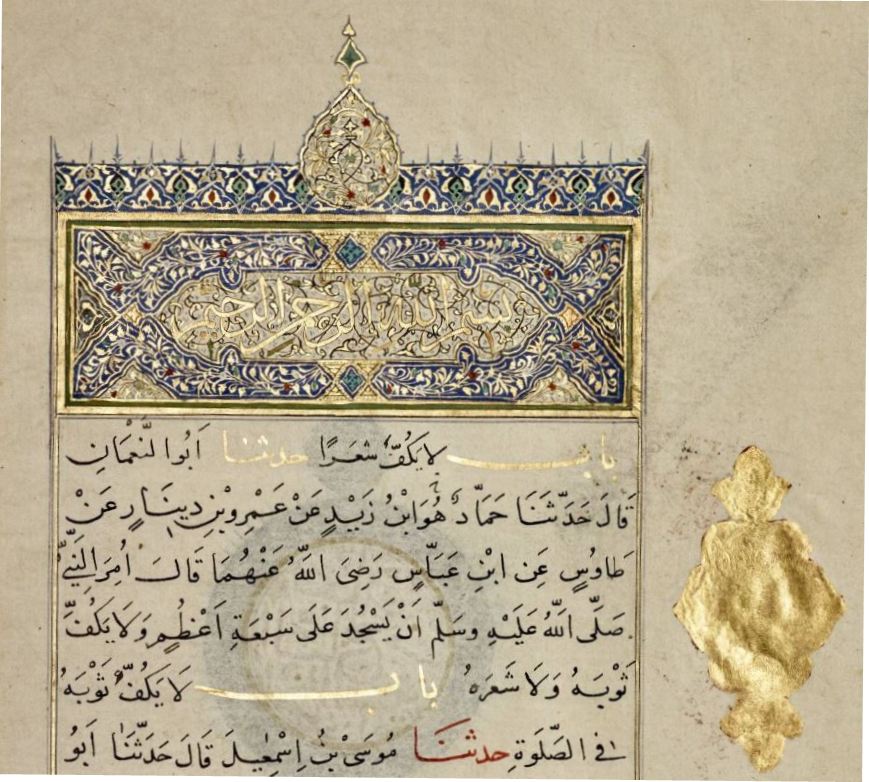
The Sunna relies on the books of the Ṣaḥīḥ hadith, which they consider the most sound and reliable books after the Qur’ān, especially the Ṣaḥīḥ of al-Bukhārī and the Ṣaḥīḥ of Muslim. Their reverence for these is second only to their holy Book, even though it was written by Persian shaykhs who were not contemporaries of the Prophet of Islam.
THESE WORKS WERE composed more than two hundred years after the death of the Prophet, when there was eyewitness transmitter of his hadiths alive when they composed them. They were written in the format of: “So-and-so heard from so-and-so and from so-and-so who heard so-and-so that it was said that …” All of them are hand-me-down accounts that have no credibility or reliable evidence value for the transmission of hadiths at a distance two hundred years after the death of their author, without any supporting documentation. Oral discourse always loses accuracy or becomes augmented with the passage of time. How, therefore, can there be any accuracy or credibility in such oral transmission after more than two centuries?
All of them are hand-me-down accounts that have no credibility or reliable evidence value
The online reference IslamWeb claims the following:
The supposed contradiction between the hadiths of the Prophet and the Qur’ān, or between them and reason, is merely an illusion caused either by the ignorance of the individual or weakness in his mental faculties. This is evidenced when one reads books in which some have attempted to collect together hadiths from the two Ṣaḥīḥs, or from one of them which they perceive to be contrary to the Qur’ān or to reason. Their writings merely demonstrate their intellectual weakness, and expose their ignorance.
Some educated and enlightened Muslims, such as Counselor Aḥmad ‘Abduh Māhir, Islām Al-Beheiri, Ibrāhīm ‘Īṣā, Shaykh Muḥammad ‘Abdullah and Dr. Tawfīq Ḥamīd, who refute these books and extract from them examples of hadiths that distort Islam and impugn the behaviour of the Prophet, along with irrational hadiths and the superstitions that populate the books, especially the works of Al-Bukhārī and Muslim. They direct swinging criticisms at the work of Al-Bukhārī and Muslim, calling for their refutation in the strongest possible terms and calling on Al-Azhar to delete them and cease including them in the education curricula due to their effect of distorting the faith and turning students into terrorists.
‘It is not permissible for the husband to spend money on medical treatment for his sick wife’
Examples of the traditions and hadiths that are unbelievable and unacceptable to the enlightened Muslim include the following:
Qubayṣa related to us, from Sufyān, from Manṣūr, from Ibrāhīm, from Al-Aswad that ‘Ā’isha said: “The Prophet and I used to take a bath from a single pot while we were Junub[i]. During the menses, he used to order me to put on an Izar (dress worn below the waist) and used to fondle me. While in I‘tikāf, he used to bring his head near me and I would wash it while I used to be in my periods (menses).[ii]
Medication with camel urine
Camel urine is a pure and a useful medicine, as the Messenger of God (peace and blessings of God be upon him) ordered him to drink it for medication, Nor does he speak out of desire. It is naught but revelation that is revealed [Qur’ān LIII (al-Najm), 3-4].[iii]
This claim of a drug originating in animal toxins is ridiculous and scientifically criticized.[iv]
‘The fetus remains dormant in the mother’s womb for four years’
The jurisprudence of the four imams indicates that it is not permissible for the husband to spend money on medical treatment for his sick wife. Is the husband therefore to enjoy marriage to his wife for his whole life while she is hale and healthy only to reject her when she is sick without caring for her treatment? Is this acceptable either religiously or socially?
Islamic law confirms that human pregnancy ‘lasts four years’
Former Grand Muftī of Egypt Muḥammad Gomaa said in a televised interview that the Sharī‘a recognizes that the fetus remains dormant in the mother’s womb for four years. This is to explain away the problem of the ‘four-year’ pregnancy of Āmina bint Wahb with the Prophet of Islam Muḥammad. It needs to cover the scandal related to the age of the Prophet’s uncle Hamza who was born four years before him, while his uncle’s mother and Muḥammad’s mother had married on the same night. In addition, the husband of Āmina (Abū Muḥammad) had died three months after his marriage to her. How could Muḥammad be born four years after his father had died and his mother had not since remarried? The following is the statement on this by IslamWeb:
We have already shown in previous fatwās that the fuqahā’ differ on the maximum duration of a pregnancy. For the Mālikīs, Shāfi‘īs and Ḥanbalīs it is four years. The Mālikīs actually hold that it is five years while the Ḥanafī school, based on the narrative of the Ḥanbalīs, put it at two years. Since the facts prove that the period was four years – there is nothing in this matter that dishonours Islam or its rulings or the sayings of their jurists.[v]
Question: Are the fuqahā’ the ones to determine the duration of a pregnancy or is it the wisdom of the Lord of the Worlds and the laws of nature and medicine? What are these facts that have proved that pregnancy lasts four years?
Islam is the only religion in the world that legitimises the rape of women captured in raids
The rape of captive women
Islam is the only religion in the world that legitimises and sanctions sexual intercourse with, and rape of, women captured in raids, even if they are ‘safeguarded’ (already married) and their husbands are still alive. Moreover, the Prophet had the right to choose for himself the most beautiful women and copulate with her without observing the ‘idda period[vi] or securing the consent of the captive, even though this is contrary to the Sharī‘a he prescribed for other Muslims! The Jewess Ṣafiyya bint Ḥayy ibn al-Akhṭab is the best example of this kind of forced rape perpetrated by the Muslims’ role model and the noblest of the Messengers. The pretext for this act was that she had consented to marrying the murderer of her father, brother and husband, and without waiting the ‘idda period and the cleaning out of her womb!
The Prophet’s attempt at suicide
In the Ṣaḥīḥ of al-Bukhārī it is mentioned that the Prophet of Islam tried several times to commit suicide after suffering from depression as a result of the death of his teacher, guide and writer of his revelation, the Christian priest Waraqa ibn Nawfal. This is because with his death the revelations to the Prophet were interrupted for a period of three years and his mission was close to failing!

Suggested Reading
One of the masterpieces of the Ṣaḥīḥ of al-Bukhārī is the following:
It is narrated from Yaḥyā ibn Qays al-Kindī from al-Sha‘bī ‘Āmir ibn Sharāḥīl and Abū Ja‘far and Abū Dharr from al-Mustamlī and Ibn Ja‘far who said: “Whoever plays with a boy and enters him, that is commits sodomy with him, he may not marry his mother. This is the view of the Ḥanbalīs, and more correctly means that he who sodomises a grown boy may not have his mother or her daughter.[vii]
Can this really be what Muslims sanctify after the Qur’ān?
[i] Junub – a state of ritual impurity (Ed).
[ii] https://sunnah.com/bukhari:299
[iii] Hadiths advising the drinking of camel urine: Bukhārī 5686; Bukhārī 6805; Muslim 1671a; Muslim 1671b. See also the claimed benefits of drinking camel urine on the online site Islam QA (the English language page on this has been removed). (Ed)
[iv] There are academic papers submitted in Saudi Arabia arguing that camel urine cures cancer, but the World Health Organization advises people not to drink camel urine because it contains a deadly virus, the MERS-CoV. (Ed)
[v] The issue of the Prophet’s birth is shrouded in mystery, in that marriage customs included the woman’s ability to ‘choose’ from the number of partners to identity as the father after giving birth. The argument is that ‘Abd Allāh (more probably ‘Abd Allāt) may not have been Muḥammad’s actual father. (Ed)
[vi] That is, the required period to laps to ensure that the woman is not already pregnant. (Ed)
[vii] The text is here. Cf. also: Bukhārī 5105.
Main image: The ḥadīth considered as a text ranking with Qur’anic scripture: a muṣḥaf-like page from the Ṣaḥīḥ al-Bukhārī with gold illumination. The passages calligraphically inscribed are Ḥadīths 815 and 816 from chapter كتاب الأذان : “The Prophet was ordered to prostrate on seven bony parts and not to tuck up his clothes or hair” (when performing ṣalāh). Unknown artist, Shiraz, dated 1400-1450. From the Keir Collection of Islamic Art, Object number K.1.2014.800.1.

